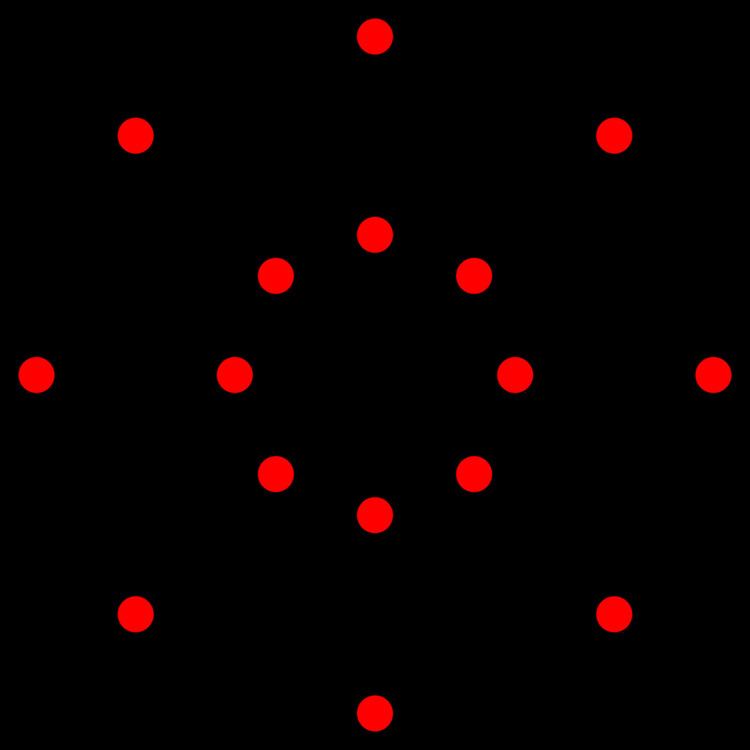 | ||
In four-dimensional geometry, a cantellated tesseract is a convex uniform 4-polytope, being a cantellation (a 2nd order truncation) of the regular tesseract.
Contents
- Cantellated tesseract
- Construction
- Cartesian coordinates
- Structure
- Projections
- Cantitruncated tesseract
- Alternative names
- References
There are four degrees of cantellations of the tesseract including with permutations truncations. Two are also derived from the 24-cell family.
Cantellated tesseract
The cantellated tesseract, bicantellated 16-cell, or small rhombated tesseract is a convex uniform 4-polytope or 4-dimensional polytope bounded by 56 cells: 8 small rhombicuboctahedra, 16 octahedra, and 32 triangular prisms.
Construction
In the process of cantellation, a polytope's 2-faces are effectively shrunk. The rhombicuboctahedron can be called a cantellated cube, since if its six faces are shrunk in their respective planes, each vertex will separate into the three vertices of the rhombicuboctahedron's triangles, and each edge will separate into two of the opposite edges of the rhombicuboctahedrons twelve non-axial squares.
When the same process is applied to the tesseract, each of the eight cubes becomes a rhombicuboctahedron in the described way. In addition however, since each cube's edge was previously shared with two other cubes, the separating edges form the three parallel edges of a triangular prism—32 triangular prisms, since there were 32 edges. Further, since each vertex was previously shared with three other cubes, the vertex would split into 12 rather than three new vertices. However, since some of the shrunken faces continues to be shared, certain pairs of these 12 potential vertices are identical to each other, and therefore only 6 new vertices are created from each original vertex (hence the cantellated tesseract's 96 vertices compared to the tesseract's 16). These six new vertices form the vertices of an octahedron—16 octahedra, since the tesseract had 16 vertices.
Cartesian coordinates
The Cartesian coordinates of the vertices of a cantellated tesseract with edge length 2 is given by all permutations of:
Structure
The 8 small rhombicuboctahedral cells are joined to each other via their axial square faces. Their non-axial square faces, which correspond with the edges of a cube, are connected to the triangular prisms. The triangular faces of the small rhombicuboctahedra and the triangular prisms are connected to the 16 octahedra.
Its structure can be imagined by means of the tesseract itself: the rhombicuboctahedra are analogous to the tesseract's cells, the triangular prisms are analogous to the tesseract's edges, and the octahedra are analogous to the tesseract's vertices.
Projections
The following is the layout of the cantellated tesseract's cells under the parallel projection into 3-dimensional space, small rhombicuboctahedron first:
This layout of cells in projection is analogous to the layout of faces in the projection of the truncated cube into 2 dimensions. Hence, the cantellated tesseract may be thought of as an analogue of the truncated cube in 4 dimensions. (It is not the only possible analogue; another close candidate is the truncated tesseract.)
Another uniform 4-polytope with a similar layout of cells is the runcitruncated 16-cell.
Cantitruncated tesseract
In geometry, the cantitruncated tesseract or great rhombated tesseract is a uniform 4-polytope (or uniform 4-dimensional polytope) that is bounded by 56 cells: 8 truncated cuboctahedra, 16 truncated tetrahedra, and 32 triangular prisms.
Construction
The cantitruncated tesseract is constructed by the cantitruncation of the tesseract. Cantitruncation is often thought of as rectification followed by truncation. However, the result of this construction would be a polytope which, while its structure would be very similar to that given by cantitruncation, not all of its faces would be uniform.
Alternatively, a uniform cantitruncated tesseract may be constructed by placing 8 uniform truncated cuboctahedra in the hyperplanes of a tesseract's cells, displaced along the coordinate axes such that their octagonal faces coincide. For an edge length of 2, this construction gives the Cartesian coordinates of its vertices as all permutations of:
Structure
The 8 truncated cuboctahedra are joined to each other via their octagonal faces, in an arrangement corresponding to the 8 cubical cells of the tesseract. They are joined to the 16 truncated tetrahedra via their hexagonal faces, and their square faces are joined to the square faces of the 32 triangular prisms. The triangular faces of the triangular prisms are joined to the truncated tetrahedra.
The truncated tetrahedra correspond with the tesseract's vertices, and the triangular prisms correspond with the tesseract's edges.
Projections
In the truncated cuboctahedron first parallel projection into 3 dimensions, the cells of the cantitruncated tesseract are laid out as follows:
This layout of cells in projection is similar to that of the cantellated tesseract.
